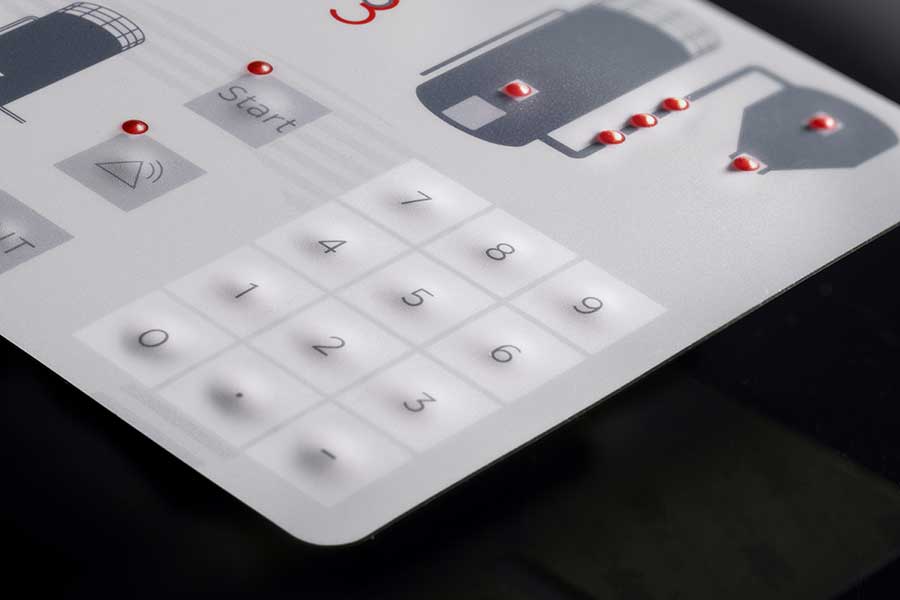Comprehending Membrane Switches: The Trick to Resilient and Reliable Controls

What Are Membrane Layer Buttons?
Membrane buttons are an advanced solution in the world of interface technology, incorporating performance and style perfectly. These gadgets offer as an interface between customers and digital systems, incorporating a number of parts into a compact format. Commonly constructed from flexible, slim layers of products, membrane switches are made to reply to touch, enabling users to communicate with machinery and digital gadgets properly.
The primary elements of a membrane layer button include a published circuit layer, visuals overlay, and a spacer layer that stops unintended activation. The visuals overlay can be tailored to show brand name identity or customer choices, boosting visual appeals while guaranteeing usability. Membrane layer switches are frequently utilized in various applications, consisting of medical tools, consumer electronics, and commercial equipment, owing to their sturdiness and resistance to environmental aspects such as dampness and dust.
Among the vital benefits of membrane layer buttons is their capacity to hold up against wear and tear, making them optimal for high-traffic atmospheres. Additionally, they are lightweight and need very little area, enabling ingenious designs in product growth. Overall, membrane layer changes stand for a practical and effective option for contemporary digital interfaces, weding innovation with user-centric design concepts.
Exactly How Membrane Switches Job
The operation of membrane layer switches joints on an easy yet reliable system that translates user input right into digital signals. When a user presses the button, the leading layer flaws, permitting a conductive element in the circuit layer to make contact with an equivalent conductive pad on the bottom of the visuals overlay.
The layout of membrane switches can vary, but they frequently include domes or responsive aspects to supply feedback to the customer, improving the overall experience - membrane switch. The products used in membrane switches, such as polyester or polycarbonate, contribute to their longevity and resistance to environmental variables, including dampness and dust. In addition, the published circuits are typically enveloped, which safeguards them from wear and tear over time.
Benefits of Membrane Layer Buttons

In addition, membrane buttons are known for their sturdiness. Built from robust products, they are resistant to dirt, dampness, and physical wear, which substantially expands their life-span compared to conventional mechanical buttons. This longevity makes them particularly appropriate for high-traffic settings and applications needing durability.
One more considerable advantage is the convenience of cleaning and upkeep. The smooth surface area of membrane layer changes reduces dust build-up and is often unsusceptible spills, making them optimal for setups that require frequent sanitization.
Moreover, membrane layer switches use a streamlined account, resulting in a thinner design that can be incorporated right into numerous devices without adding mass. This attribute not just boosts the visual charm yet likewise adds to a more ergonomic product design.
Applications of Membrane Buttons
Easy to use and functional, membrane buttons discover applications across a wide variety of markets, consisting of clinical devices, consumer electronics, and industrial tools. In the medical area, these switches are integral to tools such as analysis tools, person monitoring systems, and infusion pumps, where integrity and convenience of cleansing are vital. Their capability to preserve and stand up to harsh settings functionality makes them perfect for such applications.

In customer electronic devices, membrane layer buttons are utilized in items like microwaves, cleaning equipments, and remote controls - membrane switch. Their streamlined design enables instinctive interface, boosting the overall customer experience while providing resilience and resistance to damage
Commercial equipment additionally gains from membrane switches, specifically in control panels for equipment and automation systems. These buttons use defense against dust and wetness, making sure regular efficiency in difficult environments. Their personalized functions enable suppliers to tailor them to specific operational needs, enhancing efficiency and functionality.
Selecting the Right Membrane Layer Switch
When picking a membrane layer button, it is necessary to consider numerous elements that affect efficiency and suitability for particular applications. The primary considerations include environmental conditions, responsive feedback, longevity, and design requirements.
First, assess the operating setting; switches subjected to dampness, chemicals, or extreme temperatures call for details materials to ensure longevity and capability. Next off, assess the need for tactile feedback. Depending on individual communication, some applications might take advantage of a responsive feedback to validate activation, while others might choose a non-tactile style for aesthetic factors.
Toughness is another crucial aspect; membrane explanation switches need to be developed to stand up to frequent usage, impacts, and abrasion. my blog Make sure the selected switch can withstand the anticipated lifecycle, particularly in high-usage scenarios.

Conclusion
In verdict, membrane layer changes act as necessary components in the design of dependable and sturdy control systems across various industries. Their small layout, combined with durable construction and personalized functions, enhances customer interaction while guaranteeing longevity popular environments. The convenience of membrane layer changes enables tailored solutions that fulfill specific operational demands, enhancing their importance in modern-day innovation. As industries continue to advance, the significance of incorporating reliable membrane button options can not be overstated.
Membrane switches represent a crucial facet of modern interface style, mixing capability with strength in numerous applications.Membrane buttons are a sophisticated service in the realm of user interface modern technology, combining functionality and layout effortlessly. Usually built from versatile, slim layers of materials, membrane buttons are developed to respond to touch, allowing customers to communicate with equipment and digital gadgets successfully.
The layout of membrane layer switches can differ, yet they commonly incorporate domes or responsive elements to offer feedback to the user, improving the total experience.In verdict, membrane layer switches serve as crucial parts in the layout of dependable and resilient control systems across numerous markets.